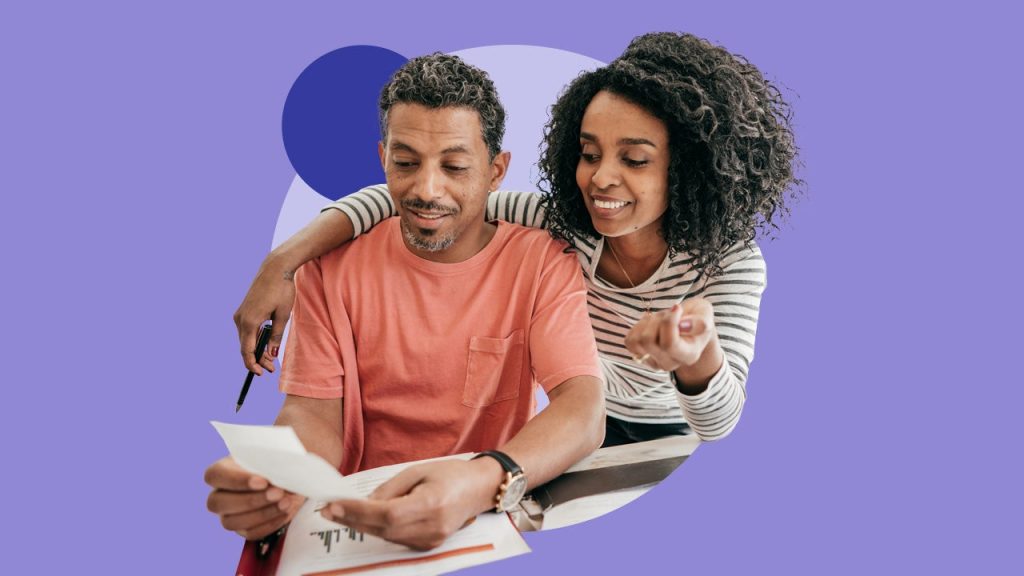Paying off debt requires carefully studying your current circumstances and understanding available options. With this information, you can create and implement a successful action plan to make your way toward a secure, debt-free future.
How to start paying off your debts
There’s an old, oft-repeated Chinese adage that “a journey of 1,000 miles begins with a single step.” When it comes to a “pay-down-debt journey,” that initial single step is a three-part process:
- Figuring out what you owe
- Pinpointing spending habits
- Building a budget to meet all expenses
1. Figure out how much you owe
Before anything else, you need to determine the exact amount of your debt. This could seem overwhelming. However, that knowledge can be empowering, giving you a starting point to plan your way out.
In addition to focusing on the dollars owed on each account, pay attention to:
- Loan interest rates
- Minimum monthly payment requirements
- Payment due dates
You’ll need all of this to determine the next steps in debt payments.
2. Inspect your spending
Once you know your debt to the dollar, the next focus should be your expenses other than debt. Calculate necessary monthly “need-to-have” costs like shelter, utilities, transportation, clothing and food from your income. The leftover represents discretionary income for the “nice-to-have” extras.
Cutting down on those extras is one key to paying down debt. Some extra things you could re-evaluate include:
- Buying more expensive brands from the grocery store.
- Dining out frequently.
- Paying for daily beverages from a local coffee shop.
- Using streaming services or gym memberships.
You could find more discretionary income with such a pinpoint analysis of your spending habits. That income, in turn, can be redirected to pay down your debt more quickly.
3. Build your budget
A budget is essential for meeting financial obligations and reaching specific goals (like debt paydowns). It gives you a plan for how you spend your money while helping you keep finances in order. The two basic ways to make room in your budget is to reduce expenses and increase income.
Additionally, “you can’t pay off debt if you don’t have your bills covered,” says Scott Waters, senior vice president of business development with Process Payments Now. Waters, who also owned and operated the Trust Accounts Receivable Group LLC collections agency, added that consumers without a budget are often behind on their bills.
You can budget on paper or with a budgeting app. Many are subscription-based, while others are free. If you want to develop your budget planner, templates are available in Excel, Microsoft Office, Google Sheets and others.
Whatever you decide, get into the habit of regularly recording all income and expenses.
How to pick a debt paydown method
Once you know what you owe and place that information into a software program or spreadsheet, it’s time to determine how to use that extra discretionary income to pay down your debt.
Waters suggested that the immediate focus should be overdue items. “The last thing you want to do is default on an account,” he says. “Once it goes to a collection agency, it can ruin your credit and also leave you open to a lawsuit, which can lead to wage garnishment and liens.”
Two common approaches when addressing debt are the snowball and avalanche strategies.
Debt snowball: Starting small
The debt snowball strategy involves making minimum payments to all creditors and focusing all extra dollars on the account with the smallest outstanding balance. Once that balance hits zero, turn your attention — and the extra money — to the next-smallest balance and work on that.
When the second debt is paid, move on to the next account, using the extra funds you now have to pay it down. Repeat the process until all balances are down to zero. As you pay down debt, the available amount “snowballs,” providing more money to pay the remaining accounts.
The snowball strategy’s main benefit is that it gives you quick wins. Small-debt paydowns tend to be faster, generating motivation to stick with the plan. This method can also be helpful if you have a lot of debt. Focusing efforts on paying off one account (while making minimum payments on others) can make the process more manageable.
“For people who have struggled to pay off debt because they feel like it’s hopeless, the snowball method is generally a better method,” Waters said.
However, the debt snowball strategy can also be costlier. While you’re paying down smaller balance tabs, balances on higher-interest accounts continue growing. When you get to that high-rate balance, you could owe a great deal based on compounding interest.
Debt avalanche: Getting rid of the large headaches first
Like the snowball method, the debt avalanche strategy requires you to make minimum payments to all creditors and lenders. Rather than focus on smaller account balances, your attention is on the debt with the highest interest rate.
When that account is paid down, the debt with the next-highest interest rate is next. When that debt reaches zero, turn to the account with the next-highest interest rate and work on that. Continue the process until all accounts show a zero balance.
The debt avalanche approach removes the most expensive debts first, meaning you save on interest payments. It can be an ideal way to go if you have multiple debt accounts with varying interest rates.
This method requires patience, especially if that high-interest-rate account represents one of your largest debts. Higher interest rates mean you owe more, which could slow down the process. While the debt avalanche strategy can reduce your costs, this works only if you’re motivated to stick with it.
How to pay off debt in other ways
Changing spending habits and implementing a payoff method are two ways to help you pay down debt — but by no means the only ones. You may want to take additional steps to get rid of debt.
Consider a part-time job
Increasing your household income through part-time work could help pay your debt more quickly.
If you can’t scrounge more hours from your primary employer, the gig economy offers multiple opportunities to earn more. Check out apps for food and grocery delivery, ride-sharing services, dog-walking and babysitting to see what’s available.
Consider this route only if it fits your schedule and doesn’t add unreasonable stress to your life. Also, be sure your primary employer is on board with you taking on part-time work. Some companies have restrictions on moonlighting.
Sell things you don’t want
You might not need that unused end table that’s been sitting in your garage for years, but it could be worth $25 to someone furnishing their first apartment from scratch. Facebook Marketplace and eBay could help you find the right buyers for your extra stuff.
Consider a garage sale if you don’t like the anonymity of online selling platforms. Neighborhoods often organize community-wide garage sales, which could attract even more people and allow you to sell items you don’t need or want.
Consider debt consolidation
Debt consolidation combines everything you owe creditors and lenders into one new combined loan.
Consolidation can help you in a couple of ways. First, it’s easier to budget, as you’re making one payment to a single source vs. multiple payments to several creditors and lenders. Second, you could save money if the interest rate is lower.
Balance transfer card
A balance transfer credit card lets you move multiple balances from other cards to a single one, which offers a 0 percent introductory APR period. You then have a period (generally six to 21 months) to pay the amount without accruing interest.
Consider what happens when that 0% introductory period is over. “These cards often carry a higher interest rate compared to the card consumers transferred from,” Waters said.
Make sure to also be aware of the fees associated with balance transfers.
Balance transfer credit cards typically require applicants to have a good to excellent credit score.
Debt consolidation loan
With a debt consolidation loan, you obtain a lump sum from a bank or personal lending institution with which you can pay off your debt and other loans. You then make monthly payments on the consolidation loan.
Most debt consolidation loans have a fixed rate that can be lower than the variable interest rates carried by credit cards.
Waters explained that debt consolidation loans can be ideal for individuals who struggle with budgets, as the process reduces multiple monthly payments to a single one. “This method is particularly helpful when the stress of handling multiple credit card payments is too much for someone to handle,” he added.
However, if the monthly estimated payment on a debt consolidation loan is more than you can afford, there might be better options. Furthermore, like balance transfer cards, such loans are usually available to those with good or excellent credit scores.
The bottom line
Paying off your debt requires preparation, patience and perseverance, but it can be done. Take the time to understand your finances and the requirements of the creditors and lenders you owe. Select the paydown methods that work with your situation and stay dedicated to get closer to being debt free.
Read the full article here















